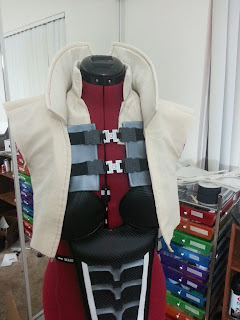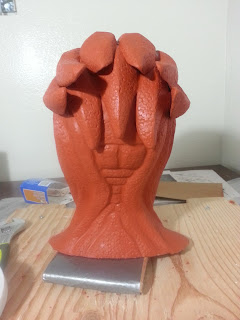When I was first making my headpiece sculpt, I was still trying to decide what costume to make. I knew I wanted to make an Asari, but I was toying between Liara and Aria. I eventually chose Aria because, when looking at her ME2 character model, the costume looked less complicated than Liara's.
So I settled on Aria.
And then the Omega DLC came out, along with a new, more detailed model (and outfit!). And I started to wonder what I had gotten myself in to.
I draft most of my costumes from scratch. I decided to start with the very centerpiece of Aria's outfit: The bustier-chest-armor-thing that I still don't know what to call it.
THIS THING:
This is the centerpiece of the entire costume; everything else is either arranged around, or attached to this one piece. It had to be completely sewn before I would be able to get anything else done.
It was also the hardest piece to make in the entire costume.
There were so many things to take in to consideration with this garment:
The texture of it was different than the body suit, so it had to be a different fabric.
The fabric I was using was an upholstery vinyl with no stretch, so it was going to have to be detached from the bodysuit as well.
The weird little cut-out between the cups meant I couldn't wear a bra with it....So the garment was going to have to be as supportive as a bra, but didn't have any of the main features a bra would (something to pull it together in the center, and no visible straps that go around the back)
This thing was a nightmare to draft and sew. It took me a solid month of drafting, sewing samples, fitting, re-drafting, sewing more samples, fitting some more, until I was finally able to get it right.
To get a pattern, I grabbed an old bra and used some scrap fabric to copy the cup shape and size.
I drafted up the front piece as well, and sewed together a sample. This piece came from...very humble beginnings.
I continued adjusting the pattern and re-sewing samples until I was happy with the fit. (I believe I went through about 4 variations of this, plus I detached and reattached the cups several times per sample) One of the main problems I had with fitting was the cups kept pulling apart from the center, because there was nothing holding them together. More on how I fixed this later.
Fabrics used:
Outside fabric: Carbon Fiber upholstery vinyl
Interfacing: 1 layer of felt, 1 layer of thick Pellon
Lining: Black cotton plain weave
For the felt and interfacing, I cut out the pieces without seam allowance. I zig-zagged the center seam of the cup together:
I initially had only used the pellon for the bra cups, but didn't like the final shape. I ended up with very pointy looking Madonna boobs. I added the layer of felt over top of the pellon, because it softened the center of the cup, and gave it a more rounded look.
The 2 inside layers were then quilted on to the cup lining
The vinyl was basted to the lining, and the edges were finished with a stretch-PVC bias tape. I needed to use a bias tape to finish the edges, because the order in which the garment was sewn wouldn't have allowed for the cups to be turned right-side-out after finishing.
 |
| I machine stitched the bias tape on at 1/8", and then hand stitched it to the inside of the garment. |
FYI The cup does have an underwire, that was harvested from an old bra.
The center cutout between the cups is also wired, so that it will keep it's shape while being worn, and prevent it from stretching.
The inset silver and white pieces were glued on to a backing with contact cement.
Everything was stitched together: Yay~
The silver panels up top are also made out of upholstery vinyl; they are what provides the "center" support for the "bra". Since I couldn't have something pulling the bra cups together at the center bottom because of the cutout, I instead used the panels above the cups to create that support instead.
Jacket:
Outer fabric: White stretch PVC
Lining: Matte Milliskin (with fusible interfacing to prevent stretching)
Stiffener for collar: Stretch Neoprin (Spacer)
I drafted and sewed up a sample of my jacket based. I was really happy with how the collar worked out.
The jacket is made from a white stretch PVC vinyl, and the lining is spandex (to match the sleeves on my body suit). I used fusible interfacing on the spandex for added stability, as well as to prevent it from stretching too much while sewing. This sort of worked; I still decided that I needed a walking foot to finish off this garment.
Unfortunately, I discovered that they do not make walking feet to fit my sewing machine, so I ended up renting a machine in order to finish this up.
The reason I needed a walking foot was because I was sewing three stretch fabrics together, and each fabric had a different amount of stretch. The Neoprin I used inside the collar was really stretchy and shifty, and to sew it I absolutely needed a walking foot.
I made a stencil out of masking tape. I mixed some acrylic paint with a textile medium, and airbrushed the Omega logo on to the back of the jacket:
Boot Covers:
Boots with the correct looking heel and toe were purchased. I hacked off the top of the boots down to the ankle.
Duct tape pattern drafting at it's finest.
The duct tape pattern was cut in to 4 pieces: inside front, outside front, inside back and outside back
I added a small amount of ease to the pattern, and sewed a mock-up out of muslin.
I then adjusted the pattern for fit, and sewed a mock-up out of a similar vinyl to what the final product would be. I drew where I wanted the style lines to be on the mock-up, and made another (several) mock-ups until it looked exactly the way I wanted the final product to look.
These boot covers are not actually glued to the shoe; they are sewn kind of like a sock that fits over the shoe. Check out this tutorial by GSTQ fashions for a better idea of what I'm talking about. I used the Neoprin spacer in the boots to stiffen them, and add thickness.
After many more samples, the final product is sewn up:
Chaps:
I got super lazy for the drafting on these. I grabbed a pair of old jeans that I liked the fit of, and drew on the style lines for the chaps. I then cut them out, and traced them on to paper.
Another mock-up in ugly gold vinyl.
Finished product:
Well, that's it for the sewing portion of the costume! Here's a list of all the fabrics I used:
Black carbon fiber vinyl - Used on the chest piece, chaps/leg armor, boot covers
Brushed Aluminium upholstery vinyl - Used for details on chest piece and leg armor
4-way stretch black matte spandex (matte vinyl look) - Used on the bodysuit
Burgundy matte milliskin - Used on bodysuit sleeves, and jacket lining
Neoprin Spacer - Used in the jacket collar, and in the boot covers
White stretch PVC/Vinyl - Used on the jacket, and details on the chest piece. I had this fabric left over from a previous project, but something like this would be pretty similar.
































































